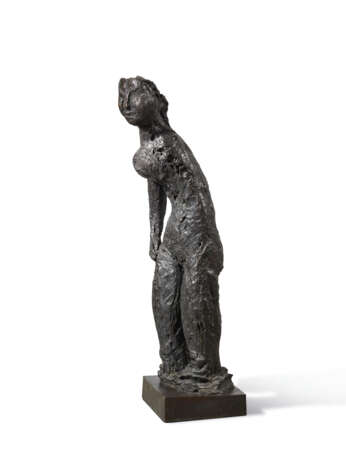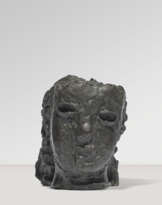ID 832076
Los 25 | Jean Fautrier (1898-1964)
Schätzwert
€ 100 000 – 150 000
Femme debout
signé et inscrit 'FAUTRIER EA II' (sur la base)
bronze à patine brune
142 x 49 x 35 cm.
Conçu en 1935; cette épreuve fondue utlérieurement dans une édition de 6 exemplaires et 2 épreuves d'artiste
signed and inscribed 'FAUTRIER EA II' (on the base)
bronze with brown patina
55 7/8 x 19 1/4 x 13 3/4 in.
Conceived in 1935; this proof cast later is in an edition of 6 and 2 artist's proofs
Provenance
Atelier de l'artiste.
Michel Couturier, Paris.
Gianna Sistu, Paris.
Rudolf Zwirner, Cologne.
Wolfgang Hahn (acquis auprès de celui-ci en 1986).
Puis par descendance au propriétaire actuel.
Literature
E. Engelberts, Jean Fautrier: Œuvre Gravé, Œuvre Sculpté: Essai D'un Catalogue Raisonné, Genève, 1969, no. 11 (une autre épreuve illustrée).
Jean Fautrier, cat. exp., Kunstverein, Hambourg, 1973, p. 108, no. 110 (une autre épreuve illustrée, p. 109).
Jean Fautrier, Matière et Lumière, cat. exp., Musée d'Art Moderne de la Ville de Paris, Paris, 2018, no. 119, p. 203 et p. 257 (une autre épreuve illustrée en couleurs, p. 202).
Special notice
Artist's Resale Right ("droit de Suite").
If the Artist's Resale Right Regulations 2006 apply to this lot, the buyer also agrees to pay us an amount equal to the resale royalty provided for in those Regulations, and we undertake to the buyer to pay such amount to the artist's collection agent.
This item will be transferred to an offsite warehouse after the sale. Please refer to department for information about storage charges and collection
details.
Post lot text
« Ses nus ont une parenté directe avec la chair et non avec des nus, comme ses paysages avec la végétation et non avec des sites, comme ses objets avec l’équivoque existence de l’inanimé et non avec des objets ». – André Malraux, réponse à un ami américain, Galerie Iolas, New York.
“His nudes have a direct kinship with flesh and not with nudes, like his landscapes which interact with vegetation and not with sites, like his objects with the equivocal existence of the inanimate and not with objects.”- André Malraux, reply to an American friend, Iolas Gallery, New York.
Quand vie et art s'entremêlent !
Le collectionneur Wolfgang Hahn, originaire de Cologne
Un intellectuel aimable et très élégant, qui a défendu la cause de l'art contemporain avec force et sans tenir compte des sensibilités : c'est ainsi que ses contemporains caractérisent le restaurateur de tableaux et collectionneur Wolfgang Hahn (1924-1987), originaire de Cologne.
En tant que directeur du département de restauration du musée Wallraf Richartz (et plus tard du musée Ludwig) à Cologne, son activité a forgé sa compréhension des chemins parfois tortueux de l'art, et ainsi son ouverture d'esprit face à la diversité des développements des années 1960 et 1970. Cet éventail lui a permis de s'intéresser de près à des tendances telles que Fluxus, le Nouveau Réalisme, l'art américain d'après-guerre ou la musique « classique » contemporaine. Parallèlement, son bagage professionnel lui a fait prendre conscience de la force évocatrice des choses, si bien qu'il a sauvé des vestiges matériels de happenings afin de préserver le message artistique pour les futures générations, lui permettant ainsi de constituer une vaste bibliothèque de référence. C'est dans ce contexte qu'est née l'une des plus importantes collections d'art contemporain d'Europe, présentée pour la première fois au public en 1968 au musée Wallraf Richartz.
Son intérêt pour la production artistique de son époque l'a conduit à de nombreuses rencontres, parfois amicales, avec des créateurs, dans une Rhénanie allemande qui était alors un centre de développement artistique contemporain. Associé à d'autres leaders d'opinion, du collectionneur Rainer Speck aux galeristes Rudolf Zwirner et Michael Werner, en passant par le conservateur Kasper König et son frère, l'éditeur de livres d'art Walter König, Wolfgang Hahn est devenu un acteur majeur d'un réseau dont les actes sont encore palpables aujourd'hui. Dans les années 1970, le musée Wallraf Richartz proposait plus de Pop Art que le MoMA de New York, et l'évolution de Peter Ludwig en collectionneur d'art du 20e siècle, et finalement en fondateur de musée, n'a sans doute pas été étrangère au rôle de conseiller, pour ne pas dire d'influenceur, de Wolfgang Hahn.
Une grande partie de sa collection a été acquise en 1978 par la République d'Autriche pour être rendue accessible au public (et élargie en 2003) au mumok - Museum moderner Kunst Stiftung Ludwig Wien. Elle fut complétée en 2005 par la donation de sa bibliothèque par sa veuve. En 2017 et 2018, le mumok de Vienne et le musée Ludwig de Cologne ont consacré une exposition spéciale à son activité de collectionneur et à son influence sur l'art de son époque.
En 1994 déjà, la « Gesellschaft für Moderne Kunst am Museum Ludwig » (Société d'art moderne du musée Ludwig) avait donné le nom de Wolfgang Hahn à son prix annuel, afin de témoigner de son attachement à l'esprit contemporain. Le prix « Wolfgang Hahn Preis KÖLN » distingue chaque année une position artistique qui n'est pas représentée dans la collection du musée Ludwig, et achète une œuvre pour l'institution. Avec un budget de 100 000 €, ce prix artistique est l'un des mieux dotés au monde ; la liste des artistes récompensés comprend notamment Lawrence Weiner, Cindy Sherman, Isa Genzken, Mike Kelley, Peter Doig, Kerry James Marshall ou Frank Bowling et, pour l'année 2023, Francis Alys.
Christie's est honorée de pouvoir proposer des œuvres de l'héritage de Wolfgang Hahn dans des ventes aux enchères à Londres et à Paris à l'automne 2022. Des artistes comme Georg Baselitz représentent l'amitié de Hahn avec le galeriste Michael Werner, tandis que Jean Fautrier représente le contexte historique et artistique du collectionneur et de la collection. Les peintures de Per Kirkeby exposées à la documenta 7 en 1982 à Cassel rappellent à leur tour l'avant-gardisme institutionnel de Hahn. La pièce maîtresse de la collection est IKB 120 d'Yves Klein, dont le titre Portrait d'Iris Clert fait référence à son amitié avec l'artiste ainsi qu'avec la légendaire galeriste parisienne (estimation € 1-1,5 million) : un rappel lumineux du rôle joué par Wolfgang Hahn dans l'histoire de la réception de l'œuvre en Allemagne.
Understanding life and art as one!
The Cologne collector Wolfgang Hahn
An amiable and impeccably dressed intellectual who championed the cause of contemporary art resolutely and without regard for sensitivities – this is how his contemporaries described Cologne restorer and collector Wolfgang Hahn (1924-1987).
As head of the restoration department of the Wallraf Richartz Museum (and later at the Museum Ludwig) in Cologne, Hahn’s work allowed him to develop an understanding of the sometimes tortuous paths of art and thus an openness to the diversity of current developments in the 1960s and 1970s. This range enabled him to engage intensively with movements such as Fluxus, Nouveau Réalisme, US post-war art or contemporary “classical” music. At the same time, his professional background gave him an awareness of the expressiveness of things, so he saved the physical remnants of happenings in order to preserve the artistic message for the future. He also built an extensive reference library. Against this background, one of Europe's most important collections of contemporary art was created. It was first shown to the public at the Wallraf Richartz Museum in 1968.
Hahn's interest in current artistic production led to numerous encounters, and sometimes friendships, with artists of the era, at a time when the German Rhineland was a centre of contemporary art development. With connections to other opinion leaders, from collector Rainer Speck via curator Kasper König and his brother, art-book publisher Walter König, to gallery owners Rudolf Zwirner and Michael Werner, Wolfgang Hahn became a central part of a network whose influence can still be seen today. Even in the 1970s, one could experience more Pop Art in the Wallraf Richartz Museum than in New York's MoMA, and the development of Peter Ludwig into a collector of 20th-century art and ultimately into a museum benefactor was probably shaped, in no small measure, by the advice, if not the influence, of Wolfgang Hahn.
In 1978, the Republic of Austria acquired large parts of his collection in order to make them accessible to the public in the mumok, the Museum of Modern Art, Ludwig Foundation, Vienna. Further purchases were made in 2003 and the collection was completed in 2005 when Hahn's widow gifted his library to the museum. In 2017 and 2018, the mumok in Vienna and the Museum Ludwig in Cologne dedicated a special exhibition to his collecting activities and his influence on the art of his time.
As early as 1994, the Gesellschaft für Moderne Kunst am Museum Ludwig [Society for Modern Art at the Museum Ludwig] named its annual prize after Wolfgang Hahn in order to make a commitment to contemporaneity. Every year, the Wolfgang Hahn Preis KÖLN [Wolfgang Hahn Prize COLOGNE] honours an artist who is not represented in the collection of the Museum Ludwig and purchases a work for it. Worth €100,000, this is one of the world's richest art prizes. Recipients include artists such as Lawrence Weiner, Cindy Sherman, Isa Genzken, Mike Kelley, Peter Doig, Kerry James Marshall, Frank Bowling and, for 2023, Francis Alys.
Christie’s is honoured to offer works from Wolfgang Hahn’s estate in auctions in London and Paris in the autumn of 2022. Artists such as Georg Baselitz represent Hahn’s friendship with gallery owner Michael Werner, while Jean Fautrier represents the art historical background of collector and collection. Per Kirkeby’s paintings, exhibited at documenta 7 in Kassel in 1982, in turn recall the institutions where Hahn used to work. Leading this group is Yves Klein's IKB 120. This work, with its title Portrait d'Iris Clert, refers to his friendship with both the artist and the legendary Parisian gallery owner (estimate €1-1.5 million): a vibrant reminder of the role Wolfgang Hahn played in the reception history of this work in Germany.
| Künstler: | Jean Fautrier (1898 - 1964) |
|---|---|
| Kunst Stil: | Moderne Kunst |
| Herkunftsort: | Westeuropa, Frankreich, Europa |
| Künstler: | Jean Fautrier (1898 - 1964) |
|---|---|
| Kunst Stil: | Moderne Kunst |
| Herkunftsort: | Westeuropa, Frankreich, Europa |
| Adresse der Versteigerung |
CHRISTIE'S 8 King Street, St. James's SW1Y 6QT London Vereinigtes Königreich | |
|---|---|---|
| Vorschau |
| |
| Telefon | +44 (0)20 7839 9060 | |
| Aufgeld | see on Website | |
| Nutzungsbedingungen | Nutzungsbedingungen |














